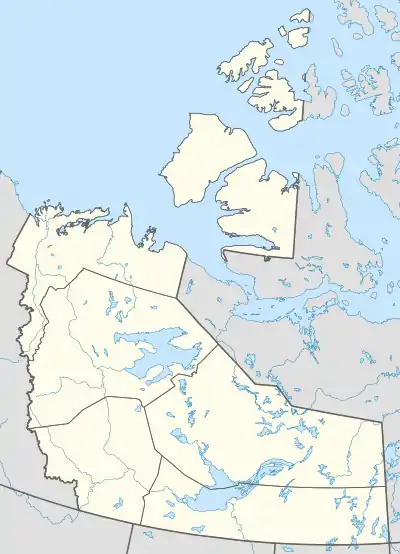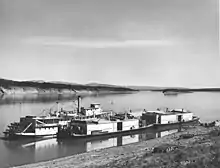Wrigley, Northwest Territories
Wrigley (South Slavey language: Pehdzeh Ki "clay place") is a "Designated Authority"[6] in the Dehcho Region of the Northwest Territories, Canada. The Slavey Dene community is located on the east bank of the Mackenzie River, just below its confluence with the Wrigley River and about 466 mi (750 km) northwest of Yellowknife.
Wrigley
Pedzéh Kñ | |
|---|---|
First Nation (Designated Authority) Pehdzeh Ki First Nation | |
 Wrigley  Wrigley | |
| Coordinates: 63°13′41″N 123°28′12″W | |
| Country | Canada |
| Territory | Northwest Territories |
| Region | Dehcho Region |
| Constituency | Nahendeh |
| Census division | Region 4 |
| Settled | 1965 |
| Government | |
| • Chief | Maurice Moses |
| • Community Officer | Sharon Pellissey |
| • MLA | Shane Thompson |
| Area | |
| • Total | 55.84 km2 (21.56 sq mi) |
| Elevation | 149 m (489 ft) |
| Population (2016)[1] | |
| • Total | 119 |
| • Density | 2.1/km2 (5/sq mi) |
| Time zone | UTC−07:00 (MST) |
| • Summer (DST) | UTC−06:00 (MDT) |
| Canadian Postal code | X0E 1E0 |
| Telephone exchange | 581 |
| - Living cost | 152.5A |
| - Food price index | 173.6B |
| Sources: Department of Municipal and Community Affairs,[2] Prince of Wales Northern Heritage Centre,[3] Canada Flight Supplement[4] ^A 2013 figure based on Edmonton = 100[5] ^B 2015 figure based on Yellowknife = 100[5] | |
Originally situated at Fort Wrigley, 16 km (9.9 mi) downstream, the community relocated to its present location in 1965, in part because it was more easily accessible due to the World War II era Wrigley Airport built for the Canol Project and also due to the swampy nature of the land around Fort Wrigley.[7][8] Today the community can be reached via the Mackenzie Highway. The population continues to maintain a traditional lifestyle, trapping, hunting, and fishing.
The community was named for Joseph Wrigley who was the Hudson's Bay Company Chief Commissioner for British North America (1884-1891).[7][9]
The Franklin Mountains, which are also on the east bank of the Mackenzie River, overlook the community. Cap Mountain, 1,228 m (4,029 ft), is the highest peak in the range and is within walking distance of the community. Although not as well known as the Rabbitkettle Hot Springs the Roche qui trempe a l’eau sulphur springs are located downstream of Wrigley.[7]
Demographics
Population is 133 according to the 2016 Census, an decrease of 10.5% from the 2011 Census The majority of the population (110 people) is First Nations and the predominant languages are North and South Slavey and English.[1]
In 2017 the Government of the Northwest Territories reported that the population was 135 with an average yearly growth rate of 1.1% from 2007.[5]
|
| ||||||||||||||||||||||||||||||||||||||||||||||||||||||||||||||||||||||||
| Sources: NWT Bureau of Statistics (2001 - 2017)[10] | |||||||||||||||||||||||||||||||||||||||||||||||||||||||||||||||||||||||||
First Nations

The Dene of the community are represented by the Pehdzeh Ki First Nation and belong to the Dehcho First Nations.[11] The last of the Numbered Treaties, Treaty 11, was signed here 13 July 1921. At that time the Headman was paid $22 and $12 for everybody else.[12]
Services
The community has one store, a health centre and a two-person Royal Canadian Mounted Police detachment.[13]
Education
The community has a K-9 school, Chief Julian Yendo School with an enrolment of 24 as of 2018. After completion of grade 9 students go to the Thomas Simpson Secondary School in Fort Simpson.[14]
Climate
Wrigley has a continental subarctic climate (Dfc). The area combines mild to warm, short summers with long and very cold winters. The differences between the coldest and warmest month are rather extreme even by continental standards, with the January high being −21 °C (−6 °F) and the July high being 23 °C (73 °F) according to Environment Canada. Transitional seasons are rather short.
| Climate data for Wrigley Airport | |||||||||||||
|---|---|---|---|---|---|---|---|---|---|---|---|---|---|
| Month | Jan | Feb | Mar | Apr | May | Jun | Jul | Aug | Sep | Oct | Nov | Dec | Year |
| Record high humidex | 11.2 | 10.0 | 12.0 | 24.0 | 30.4 | 38.1 | 37.9 | 36.6 | 29.8 | 21.3 | 7.2 | 0.0 | 38.1 |
| Record high °C (°F) | 6.5 (43.7) |
11.1 (52.0) |
12.7 (54.9) |
25.0 (77.0) |
34.0 (93.2) |
37.0 (98.6) |
35.5 (95.9) |
33.5 (92.3) |
28.3 (82.9) |
21.7 (71.1) |
8.9 (48.0) |
7.8 (46.0) |
37.0 (98.6) |
| Average high °C (°F) | −21.1 (−6.0) |
−17.1 (1.2) |
−7.9 (17.8) |
5.0 (41.0) |
14.6 (58.3) |
21.7 (71.1) |
23.4 (74.1) |
19.9 (67.8) |
12.5 (54.5) |
−0.3 (31.5) |
−14.8 (5.4) |
−18.6 (−1.5) |
1.5 (34.7) |
| Daily mean °C (°F) | −25.4 (−13.7) |
−22.1 (−7.8) |
−15.0 (5.0) |
−1.7 (28.9) |
8.0 (46.4) |
15.0 (59.0) |
16.9 (62.4) |
13.6 (56.5) |
7.1 (44.8) |
−3.8 (25.2) |
−18.7 (−1.7) |
−22.7 (−8.9) |
−4.1 (24.6) |
| Average low °C (°F) | −29.7 (−21.5) |
−27.2 (−17.0) |
−22.1 (−7.8) |
−8.3 (17.1) |
1.3 (34.3) |
8.2 (46.8) |
10.3 (50.5) |
7.2 (45.0) |
1.6 (34.9) |
−7.4 (18.7) |
−22.5 (−8.5) |
−26.7 (−16.1) |
−9.6 (14.7) |
| Record low °C (°F) | −51.7 (−61.1) |
−53.3 (−63.9) |
−46.7 (−52.1) |
−36.1 (−33.0) |
−20.9 (−5.6) |
−3.9 (25.0) |
−1.1 (30.0) |
−6.0 (21.2) |
−18.0 (−0.4) |
−31.5 (−24.7) |
−48.0 (−54.4) |
−49.4 (−56.9) |
−53.3 (−63.9) |
| Record low wind chill | −60.9 | −58.9 | −50.3 | −37.0 | −25.5 | 0.0 | 0.0 | −2.7 | −15.6 | −37.6 | −52.1 | −63.0 | −63.0 |
| Average precipitation mm (inches) | 16.7 (0.66) |
14.6 (0.57) |
10.4 (0.41) |
8.1 (0.32) |
22.0 (0.87) |
43.5 (1.71) |
64.0 (2.52) |
49.5 (1.95) |
35.9 (1.41) |
29.4 (1.16) |
20.5 (0.81) |
18.1 (0.71) |
332.6 (13.09) |
| Average rainfall mm (inches) | 0.0 (0.0) |
0.0 (0.0) |
0.0 (0.0) |
0.3 (0.01) |
18.4 (0.72) |
43.5 (1.71) |
64.0 (2.52) |
49.5 (1.95) |
32.3 (1.27) |
7.6 (0.30) |
0.0 (0.0) |
0.0 (0.0) |
215.5 (8.48) |
| Average snowfall cm (inches) | 19.1 (7.5) |
15.4 (6.1) |
10.9 (4.3) |
8.9 (3.5) |
3.8 (1.5) |
0.0 (0.0) |
0.0 (0.0) |
0.0 (0.0) |
3.4 (1.3) |
21.8 (8.6) |
22.6 (8.9) |
18.9 (7.4) |
124.7 (49.1) |
| Average precipitation days (≥ 0.2 mm) | 8.0 | 6.4 | 5.6 | 3.3 | 6.4 | 8.4 | 9.7 | 9.0 | 9.2 | 9.7 | 9.0 | 7.5 | 92.1 |
| Average rainy days (≥ 0.2 mm) | 0.0 | 0.0 | 0.0 | 0.4 | 5.6 | 8.2 | 9.7 | 9.0 | 8.3 | 2.2 | 0.1 | 0.0 | 43.3 |
| Average snowy days (≥ 0.2 cm) | 8.0 | 6.4 | 5.6 | 2.9 | 1.1 | 0.0 | 0.0 | 0.0 | 1.1 | 7.9 | 9.1 | 7.5 | 49.4 |
| Source: Environment Canada Canadian Climate Normals 1981–2010[15] | |||||||||||||
References
- Census Profile, 2016 Census Wrigley, Settlement (Census subdivision), Northwest Territories and Northwest Territories (Territory)
- "NWT Communities - Wrigley". Government of the Northwest Territories: Department of Municipal and Community Affairs. Retrieved 2014-01-29.
- "Northwest Territories Official Community Names and Pronunciation Guide". Prince of Wales Northern Heritage Centre. Yellowknife: Education, Culture and Employment, Government of the Northwest Territories. Archived from the original on 2016-01-13. Retrieved 2016-01-13.]
- Canada Flight Supplement. Effective 0901Z 16 July 2020 to 0901Z 10 September 2020.
- Wrigley - Statistical Profile at the GNWT
- Differences in Community Government Structure
- Wrigley at Spectacular NWT
- Wrigley at the GNWT
- Memorable Manitobans: Joseph Wrigley (1839-?)
- Population Estimates By Community from the GNWT
- Pehdzeh Ki First Nation at the Dehcho First Nations
- No. 11 (June 27, 1921) and Adhesion (July 17, 1922) with Reports, etc.
- Wrigley Infrastructure Profile
- Chief Julian Yendo School
- "Wrigley A" (CSV (3069 KB)). Canadian Climate Normals 1981–2010. Environment Canada. Climate ID: 2204000. Retrieved 2014-01-09.